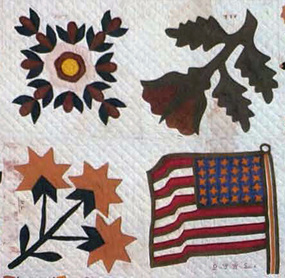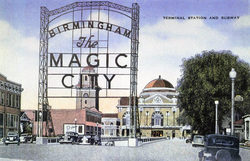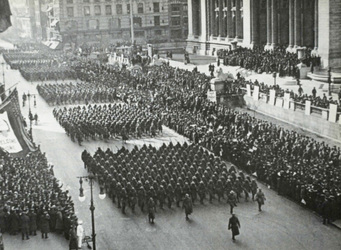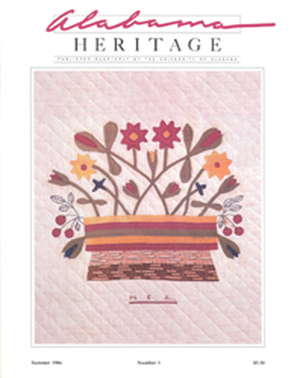FEATURE ABSTRACTS
 A detail from the Lanford album quilt. (Courtesy
A detail from the Lanford album quilt. (Courtesy Birmingham Museum of Art and
Robert and Helen Cargo)
Stitches in Time: The Lanford Album Quilt
By Rogert Cargo and G. Ward Hubbs
An old quilt invites questions: When was it made? Why, and by whom? One answers such questions hesitantly, if at all, for quilts, like most personal items whose histories trail along with them from one generation to the next, are difficult to document. In rare instances, however, one comes upon a quilt whose story is stitched into the fabric itself, left there by the artisans years earlier for anyone interested enough to look. Such is the case with the Lanford quilt, and the story it tells offers a rare glimpse into the life of one small community in the Alabama Black Belt three years before the Civil War began.
Additional Information
About the Authors
Robert Cargo, professor of romance languages and classics at the University of Alabama, has been studying and collecting quilts for more than thirty years. G. Ward Hubbs, a local historian, is currently writing an illustrated history of Tuscaloosa County. Recently, Cargo and Hubbs pooled their talents to unravel the history of the Lanford album quilt, which has been part of Robert and Helen Cargo's extensive quilt collection since 1970.
First exhibited in 1970 at a local showing in Marion, Alabama, the Lanford quilt has subsequently been displayed at an exhibition organized in 1981 by the Birmingham Museum of Art (also shown at the Montgomery Museum of Art) and was included in the catalogue accompanying that exhibit: Black Belt to Hill Country: Alabama Quilts from the Robert and Helen Cargo Collection (Birmingham Museum of Art, 1982). More recently, the Lanford quilt was one of five quilts
selected for the first major Southern folk art exhibition at the Museum of American Folk Art in New York (May 15-August 25, 1985), an exhibition now touring the South. The Lanford quilt is included in the catalogue accompanying the
exhibit: Cynthia Elyce Rubin, ed., Southern Folk Art, (Oxmoor House, 1985).
For their assistance in identifying plants in the quilt design, the authors wish to thank botanists Larry Davenport of Samford University, and Charles O'Kelley and Robert Haynes of the University of Alabama.
By Rogert Cargo and G. Ward Hubbs
An old quilt invites questions: When was it made? Why, and by whom? One answers such questions hesitantly, if at all, for quilts, like most personal items whose histories trail along with them from one generation to the next, are difficult to document. In rare instances, however, one comes upon a quilt whose story is stitched into the fabric itself, left there by the artisans years earlier for anyone interested enough to look. Such is the case with the Lanford quilt, and the story it tells offers a rare glimpse into the life of one small community in the Alabama Black Belt three years before the Civil War began.
Additional Information
- Katzenberg, Dena S. Baltimore Album Quilts (The Baltimore Museum of Art, 1981).
- Lispett, Linda Otto. Remember Me: Women & Their Friendship Quilts (The Quilt Digest Press, 1985).
About the Authors
Robert Cargo, professor of romance languages and classics at the University of Alabama, has been studying and collecting quilts for more than thirty years. G. Ward Hubbs, a local historian, is currently writing an illustrated history of Tuscaloosa County. Recently, Cargo and Hubbs pooled their talents to unravel the history of the Lanford album quilt, which has been part of Robert and Helen Cargo's extensive quilt collection since 1970.
First exhibited in 1970 at a local showing in Marion, Alabama, the Lanford quilt has subsequently been displayed at an exhibition organized in 1981 by the Birmingham Museum of Art (also shown at the Montgomery Museum of Art) and was included in the catalogue accompanying that exhibit: Black Belt to Hill Country: Alabama Quilts from the Robert and Helen Cargo Collection (Birmingham Museum of Art, 1982). More recently, the Lanford quilt was one of five quilts
selected for the first major Southern folk art exhibition at the Museum of American Folk Art in New York (May 15-August 25, 1985), an exhibition now touring the South. The Lanford quilt is included in the catalogue accompanying the
exhibit: Cynthia Elyce Rubin, ed., Southern Folk Art, (Oxmoor House, 1985).
For their assistance in identifying plants in the quilt design, the authors wish to thank botanists Larry Davenport of Samford University, and Charles O'Kelley and Robert Haynes of the University of Alabama.
|
|
|
 William G. Little, who introduced football
William G. Little, who introduced football to the University of Alabama in 1892.
(Courtesy W.S. Hoole Special Collections
Library, University of Alabama)
The Sporting Life
By Fred Hobson
Southerners, taken as a whole, seem to take sports more seriously than people in other parts of America. Stock car racing, football, baseball and basketball bulk large in the South as important entertainments. These sports provide a lens through which to view the changing nature of Southern society as it moved from agrarian to industrialized. Fred Hobson argues that high school and college sports, in particular, provide the South with an organic, indigenous, almost religious experience. It is an experience that is, he argues, uniquely Southern.
Additional Information
About the Author
In his essay "The Sporting Life," Fred Hobson, a native North Carolinian, brings together two of his lifelong passions--sports (a subject on which he rarely writes) and the South (a subject he writes about frequently). Hobson began his writing career on the editorial staff of the Winston-Salem Journal and Sentinel, where he and his fellow editorial writers shared the 1970 Pulitzer prize for Meritorious Public Service for a series of editorials. After completing a Ph.D. at the University of North Carolina in 1972, Hobson joined the English faculty at the University of Alabama, where, in 1985, he received the Burnum Distinguished Faculty Award for excellence in research and teaching.
By Fred Hobson
Southerners, taken as a whole, seem to take sports more seriously than people in other parts of America. Stock car racing, football, baseball and basketball bulk large in the South as important entertainments. These sports provide a lens through which to view the changing nature of Southern society as it moved from agrarian to industrialized. Fred Hobson argues that high school and college sports, in particular, provide the South with an organic, indigenous, almost religious experience. It is an experience that is, he argues, uniquely Southern.
Additional Information
- Riess, Steven A. The American Sporting Experience: A Historical Anthology of Sport in America (Leisure Press, 1984).
- Hobson, Fred C., Jr. Serpent in Eden: H. L. Mencken and the South (University of North Carolina Press, 1974).
- _____. Tell about the South: The Southern Rage to Explain (Louisiana State University Press, 1983). Winner of the 1983 Jules F. Landry Award for Southern history, literature, and biography.
- Hobson, Fred, ed. South-Watching: Selected Essays by Gerald W. Johnson (University of North Carolina Press, 1983). Winner of the Lillian Smith Award for nonfiction.
- Bogardus, Ralph F., and Fred Hobson, eds. Literature at the Barricades: Essays on the American Writer in the 1930s (University of Alabama Press, 1982).
About the Author
In his essay "The Sporting Life," Fred Hobson, a native North Carolinian, brings together two of his lifelong passions--sports (a subject on which he rarely writes) and the South (a subject he writes about frequently). Hobson began his writing career on the editorial staff of the Winston-Salem Journal and Sentinel, where he and his fellow editorial writers shared the 1970 Pulitzer prize for Meritorious Public Service for a series of editorials. After completing a Ph.D. at the University of North Carolina in 1972, Hobson joined the English faculty at the University of Alabama, where, in 1985, he received the Burnum Distinguished Faculty Award for excellence in research and teaching.
 "The Magic City" sign erected in 1926 at the
"The Magic City" sign erected in 1926 at the Terminal Station in downtown Birmingham.
(Courtesy Birmingham Public Library)
Feuds, Factions, and Reform: Politics in Early Birmingham
By Leah Rawls Atkins
Since the birth of Birmingham in a cornfield after the Civil War, the politicos who controlled city government have been the subject of local and sometimes national controversies. Through the 115 years of Birmingham's history to 1986, its government has been surrounded by charges of corruption, of demagogy, of political payoffs. The conflicts have been colorful and fierce. In this article, Leah Rawls Atkins traces the history of Birmingham politics from the creation of the city in the Reconstruction South until the eve of the Civil Rights movement.
Additional Information
About the Author
Leah Rawls Atkins, a Birmingham native, holds a doctorate in history from Auburn University. She has taught at Auburn, at the University of Alabama at Birmingham, and at Samford University, where she was a member of the history faculty for thirteen years. In 1985, Atkins returned to Auburn University as director of the Center for the Arts and Humanities, housed in the historic nineteenth-century cottage, Pebble Hill. Atkins' illustrated history of Birmingham and Jefferson County, The Valley and the Hills (Windsor Press, 1981), traces the history of the area from settlement to the present.
By Leah Rawls Atkins
Since the birth of Birmingham in a cornfield after the Civil War, the politicos who controlled city government have been the subject of local and sometimes national controversies. Through the 115 years of Birmingham's history to 1986, its government has been surrounded by charges of corruption, of demagogy, of political payoffs. The conflicts have been colorful and fierce. In this article, Leah Rawls Atkins traces the history of Birmingham politics from the creation of the city in the Reconstruction South until the eve of the Civil Rights movement.
Additional Information
- Breedlove, Michael A. "Progressivism and Nativism: The Race for the Presidency of the City Commission of Birmingham, Alabama in 1917," Journal of the Binningham Historical Society, 6 Ouly 1980): 3-9.
- Fell, Charles A. "The Crash and Moratorium," Journal of the Birmingham Historical Society, 1 Oanuary 1960): 7-10.
- Flynt, Wayne. "Religion in the Urban South: The Divided Religious Mind of Birmingham, 1900-1930," Alabama Review 30 (April 1977): 108-34.
- Hamilton, Virginia Van der Veer. Hugo Black: The Alabama Years (Louisiana State University Press, 1972).
- Harris, Carl V. "Annexation Struggles and Political Power in Birmingham, Alabama, 1890-1910," Alabama Review 27 (July 1974): 163-84.
- _____. Political Power in Binningham, 1871-1921 (University of Tennessee Press, 1977).
- McMillan, Malcolm Cook. Constitutional Development in Alabama, 1798-1901: A Study in Politics, the Negro, and Sectionalism (University of North Carolina Press, 1955).
- Snell, William R. "Masked Men in the Magic City: Activities of the Revised Klan in Birmingham, 1916-1940," Alabama Historical Quarterly 34 (Fall and Winter 1972): 206-27.
- Woodward, C. Vann. Origins of the New South, 1877-1913, Vol. 9 in A History of the South edited by Wendell Holmes Stephenson and E. Merton Coulter (Louisiana State University Press, 1951).
About the Author
Leah Rawls Atkins, a Birmingham native, holds a doctorate in history from Auburn University. She has taught at Auburn, at the University of Alabama at Birmingham, and at Samford University, where she was a member of the history faculty for thirteen years. In 1985, Atkins returned to Auburn University as director of the Center for the Arts and Humanities, housed in the historic nineteenth-century cottage, Pebble Hill. Atkins' illustrated history of Birmingham and Jefferson County, The Valley and the Hills (Windsor Press, 1981), traces the history of the area from settlement to the present.
 Huge crowds line Fifth Avenue as the "Hellfighters,"
Huge crowds line Fifth Avenue as the "Hellfighters,"the Fifteenth colored regiment of New York's
National guard, return home in triumph from WWI.
(Courtesy Dept. of American Studies, University of Alabama)
The Conquests of Europe: The Remarkable Career of James Reese Europe
By Reid Badger
James Reese Europe was an African American arranger, orchestrator, conductor, and songwriter--a star of the early twentieth century. He took jazz from the saloons and made it respectable; New York's elite learned to stumble through the tango and the maxixe to the music of Europe's Society Orchestra. During World War I, Europe led a brass band for the army, and when the war ended huge crows lined Fifth Avenue in New York to watch Europe's regiment--dubbed the "Hellfighters"--return. Europe's reputation has suffered in part because he was a transitional figure, difficult for historians to place. He had, however, a pioneering role as the initiator of a number of important directions in American and Afro-American musical history.
Additional Information
About the Author
Reid Badger, associate professor of American studies at the University of Alabama, holds an undergraduate degree from the United States Naval Academy and a doctorate from Syracuse University, where he specialized in the study of late Victorian and early twentieth-century America. A member of the University of Alabama faculty since 1974, he has taught courses in American popular music and jazz for several years and is currently studying the impact of the South on the national culture in the 1920s. The author wishes to thank Mr. James Reese Europe, Jr., for his assistance in compiling information for this article.
By Reid Badger
James Reese Europe was an African American arranger, orchestrator, conductor, and songwriter--a star of the early twentieth century. He took jazz from the saloons and made it respectable; New York's elite learned to stumble through the tango and the maxixe to the music of Europe's Society Orchestra. During World War I, Europe led a brass band for the army, and when the war ended huge crows lined Fifth Avenue in New York to watch Europe's regiment--dubbed the "Hellfighters"--return. Europe's reputation has suffered in part because he was a transitional figure, difficult for historians to place. He had, however, a pioneering role as the initiator of a number of important directions in American and Afro-American musical history.
Additional Information
- Castle, Irene Foote. Castles in the Air (Doubleday, 1958).
- Castle, Vernon and Irene. Modern Dancing (Harper, 1914; reprint, Da Capo, 1980).
- Charters, Samuel B. and Leonard Kunstadt. Jazz: A History of the New York Scene (Doubleday, 1962).
- Johnson, James Weldon. Black Manhattan (Alfred A. Knopf, 1930).
- Kimball, Robert, and William Balcom. Reminiscing with Sissle and Blake (Viking Press, 1973).
- Lewis, David Levering. When Harlem Was in Vogue (Alfred A. Knopf, 1981).
- Little, Arthur W. From Harlem to the Rhine: The Story of New York 's Colored Volunteers (Covici & Friede, 1936).
- Schuller, Gunter. "Europe, James Reese (1881-1919)," in The Dictionary of American Negro Biography, Rayford W. Logan and Michael R. Winston, eds. (W. W. Norton, 1982), pp. 214-215.
- _____. Early Jazz: Its Roots and Musical Development (Oxford University Press, 1968).
- Southern, Eileen. Readings in Black American Music, 2nd. ed. (W. W. Norton, 1983).
- Waldo, Terry. This is Ragtime (Hawthorn Books, 1976).
- Wilder, Alec. American Popular Song: The Great Innovators, 1900-1950 (Oxford University Press, 1972).
About the Author
Reid Badger, associate professor of American studies at the University of Alabama, holds an undergraduate degree from the United States Naval Academy and a doctorate from Syracuse University, where he specialized in the study of late Victorian and early twentieth-century America. A member of the University of Alabama faculty since 1974, he has taught courses in American popular music and jazz for several years and is currently studying the impact of the South on the national culture in the 1920s. The author wishes to thank Mr. James Reese Europe, Jr., for his assistance in compiling information for this article.
